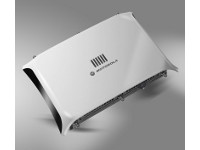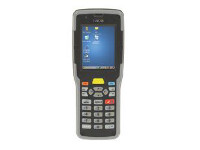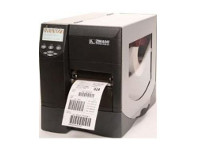Motorola AP 7131 Wireless Access Point Features
AP 7131 Wireless Access Point Features
The AP 7131 802.11n Wireless Access Point delivers the throughput, coverage and resiliency required to build an all-wireless enterprise. The tri-radio design provides simultaneous support for high-speed wireless voice and data services, self-healing mesh networking and non-data applications such as Motorola’s Wireless IPS. The fully DFS-compliant 802.11n Draft 2.0 device offers speeds up to 600 Mbps per access point — six times the bandwidth of an 802.11a/g access point. And Adaptive AP provides unparalleled resiliency and flexibility, enabling the AP 7131 to be deployed as either a stand-alone wireless access point or adopted by a Motorola wireless switch for centralized configuration and management.
Unmatched RF performance
Conducted transmit power of 27.7dBm and superior receive sensitivity provide best in class range, coverage and application performance, even in harsh RF conditions
802.11n support with 3X3 MIMO
Delivers maximum wireless network throughput to support virtually any enterprise application, including voice and video
Band-unlocked dual band design
The ability to dedicate multiple radios to multiple functions increases security without increasing costs; band-unlocked radios enable 24x7 dual band Wireless IPS sensing on both 2.4GHz and 5GHz with concurrent 802.11a/b/g/n client access and mesh
Gap-free dedicated 24x7 sensing via triple methodology rogue AP detection: on-channel, mobile unit and dedicated radio dual-band scanning
Around the clock network protection through instant rogue detection
Spectrum Analysis
The ability to place a remote AP-7131 in Spectrum Analysis mode allows remote identification of local RF interference, enabling remote troubleshooting and issue resolution from the Network Operation Center (NOC) or other centralized location
Adaptive AP: extending the enterprise
Enables centralized management of mesh access points at remote sites including automatic firmware upgrades; provides site survivability for remote locations with 802.11a/b/g/n networks for unparalleled resiliency
802.3af dual-radio support
Standard Power-over-Ethernet (PoE) provides power for both radios; intelligent power management enables self-configuration based on available power; eliminates the need to upgrade the PoE infrastructure
Integrated Router, DHCP server, Stateful Packet Inspection Firewall, AAA server, NAT, and Hotspot Gateway
Eliminates need to purchase and manage additional equipment; simplifies provisioning of network services and public access
Mesh networking
Allows wireless extension of existing wired or wireless networks in remote or outdoor locations
802.11i, WPA2, WPA and IPSec encryption
End-to-end enterprise class wired and wireless security
Motorola AP 7131 Wireless Access Point Specifications
Physical Characteristics
Available mount configurations
No additional hardware required to mount on desktop, above drop ceiling, under ceiling or on wall
Housing
Metal, Plenum-rated housing
LEDs
6 top mounted LEDs, 1 bottom mounted LED, with multiple modes indicating 802.11a/g/n activity, power, adoption, WIPS and errors
Physical interfaces
2 ports (GE1, GE2) Auto-sensing 10/100/1000 Base-T Ethernet; 802.3af on GE1 LAN port
Weight
AP-7131: 2.33 lbs/1.06 kg; AP-7131N: 2.67 lbs/1.21 kg
Dimensions (HxWxD)
AP-7131: 5.50 in. L x 8.00 in. W x 1.10 in. H 13.97 cm L x 20.32 cm W x 2.79 cm H; AP-7131N: 5.50 in. L x 8.00 in. W x 1.5 in. H 13.97 cm L x 20.32 cm W x 3.81 cm H
Power Specifications
Operating current
Max 600 mA at 48VDC
Operating voltage
36-57VDC
Integrated power over ethernet support
802.3af support for dual radio, 802.3at draft power injector
Radio Specifications and Networking
Maximum transmit power settings
23dBm (AP-7131N); 20dBm (AP-7131)(dependent on regulatory rules andcertification agency)
Data rates supported
802.11b/g: 1, 2, 5.5, 11, 6, 9, 12, 18, 24, 36, 48, and 54Mbps 802.11a: 6, 9, 12, 18, 24, 36, 48, and 54Mbps 802.11n: MCS 0-15 up to 300Mbps
Network standards
IEEE 802.11a/b/g/n (Draft 2.0), 802.11d and 802.11i WPA2, WMM and WMM-UAPSD
Operating bands – EU
2.412 to 2.472 GHz; 5.150 to 5.250 GHz; 5.250 to 5.350 GHz; 5.470 to 5.725 GHz (Country Specific)
Operating bands – FCC
2.412 to 2.462 GHz; 5.150 to 5.250 (UNII -1); 5.250 to 5.350 (UNII -2); 5.470 to 5.725 GHz(UNII -3); 5.725 to 5.850 (ISM)
Operating bands – Japan
2.412 to 2.484 GHz; 4.900 to 5.000 GHz; 5.150 to 5.250 GHz (W52); 5.250 to 5.350 GHz (W53); 5.470 to 5.725 GHz (W56)
Operating channels
All Channels from 4920 – 5825 MHz; Chan 1-13 (2412-2472 MHz), Chan 14 (2484 MHz) Japan only; Actual operating frequencies depend on regulatory rules and certification agency
Wireless medium
Direct Sequence Spread Spectrum (DSSS) Orthogonal Frequency Division Multiplexing (OFDM) and Spatial Multiplexing (MIMO)
Layer 2 and Layer 3
Layer 3 routing, 802.11-802.3 bridging, 802.1q VLAN tagging and trunking, Dyn DNS, DHCP server/client, PPPoE
Management
Adaptive Management by Centralized Switch, SSH, Telnet, SNMP v1/v2/v3, Auto-configuration with DHCP options, RFMS
QoS
WMM, WMM-UAPSD, 802.1p, DiffServ, TOS
Security
Stateful Firewall, NAT, 802.1x, 802.11i, WPA2-CCMP (AES), WPA2-TKIP, WPA-TKIP, Triple-Methodology Rogue Detection with 24×7 dual-band Wireless IPS sensing, Secure guest access (HotSpot)
User Environment
Electrostatic discharge
15 kV air, 8 kV contact
Operating altitude
8000 ft. (2438 m) @ 82° F (28° C)
Operating humidity
5 to 95% RH non condensing
Operating temperature
-4° – 122° F (-20° to 50° C)
Storage altitude
15000 ft. (4572 m) @ 53° F (12° C)
Storage temperature
-40° to 158° F (-40° to 70° C)






